As an Amazon Associate, we earn from qualifying purchases with no additional costs for you.
There are many different types of knives, each with its own purpose and function, affecting how the edge of the knife will wear. Most people own multiple types of knives, each with different sharpening requirements. How frequently should you sharpen each different kind of knife?
Knives in daily use will require sharpening and honing more frequently than knives used less often. The quality of the steel and the harshness of use will have a role to play in how often the knife is sharpened. Regular honing of the knife edge will reduce the frequency of sharpening required.
Sharpening a knife too often can almost be as bad as not sharpening your knives enough. Many knife owners are not sure about the frequency of knife sharpening. Different knives have different sharpening needs, and you need to consider the type of steel and how the knife is used to determine sharpening frequency!
If you are interested in checking out the best whetstones for your knives, we recommend and use you can find them by clicking here (Amazon link).

How Often Do You Need To Sharpen A Knife
Many new knife owners grapple with the question of how often they should sharpen their knives. Working with a dull knife has inherent dangers, and sharpening a knife too often can unnecessarily shorten the life of the knife.
The key to sharpening frequency is to find that “Goldilocks zone” where your sharpening is not too little and not too much, but just right!
Finding this happy medium where your knives are always sharp and ready for use without creating too much wear on the blade will vary for each type of knife and how frequently you put the knife to use.
Knives that are used more frequently and knives that work harder than most other knives will require a more frequent sharpening schedule to keep the knives at optimal sharpness and usefulness.
Less heavily used knives will require less sharpening in comparison to your heavily used knives. As a result, it is unnecessary to sharpen every knife in your collection every time you have a sharpening session. Only sharpen the knives that need this type of extra attention.
At some point, with some experience, you will develop a knife sharpening schedule that includes each knife you own that will give every knife the right amount of care based on use.
Is It Necessary To Sharpen A Knife Every Time You Use It?
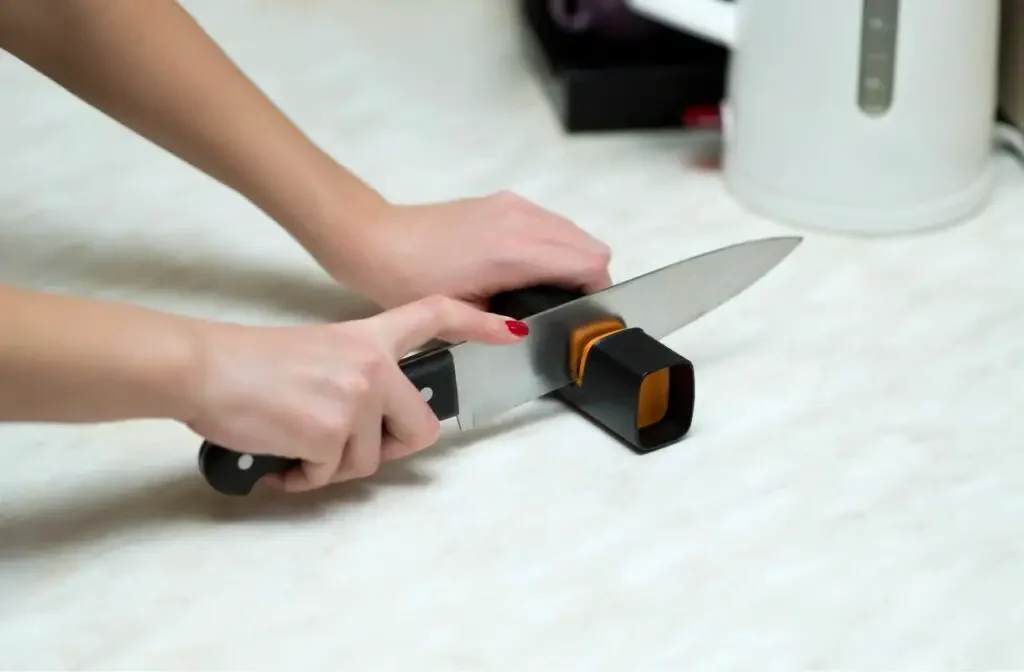
Anyone who has been using knives for some time will understand the benefits of a sharp edge on their knives. A sharp knife is more efficient and safe to use, and you will get through your tasks with better performance from the knife.
Using a dull knife can also cause further damage to the edge, resulting in more extensive repairs required on the edge when sharpening. A dull knife requires extra pressure to force the edge through the material, which further damages an edge that is already not optimal!
Understanding this concept of knife edge care and the importance of working with a sharp edge prompts many people to believe that a knife should be sharpened every time they use the knife.
Some knives may require sharpening every time you use them, but this is normally the exception rather than the rule. Some knives even require sharpening before you use them and several times during their use as well.
Sharpening Vs. Honing A Knife
A distinction must also be drawn between sharpening and honing. Many people use the two terms interchangeably, but they are two quite different processes in knife care.
The process of sharpening is a more aggressive process than honing a knife. Sharpening involves using lower grit abrasives to remove metal from the knife’s edge to re-establish the thin, sharp cutting edge.
Sharpening is typically performed with whetstones or sharpening systems using a progression of grits, from coarse to medium and fine.
In contrast, honing removes very little to no additional material from the knife, depending on the method used. Honing is the process of refining an already sharp cutting edge that simply needs a touch-up to restore keenness.
Honing a knife can be done using a honing rod, leather strop, or high-grit whetstones, depending on the knife type and your preference.
Honing can be performed more frequently than sharpening because it is a less aggressive process and does not add sufficient wear to the blade to reduce the knife’s lifespan.
As we have mentioned, honing and sharpening are often referred to by the term “sharpening” a knife. Although the processes are different, both result in a sharp knife after performing these tasks on your knife.
TIP: Sharpening and honing are two knife sharpening terms that fall into a grey area of lack of understanding. Check out the what the differences between sharpening and honing are in the article below:
Sharpening vs. Honing: Simple Explanation & Differences
How Often Should I Sharpen My Knives
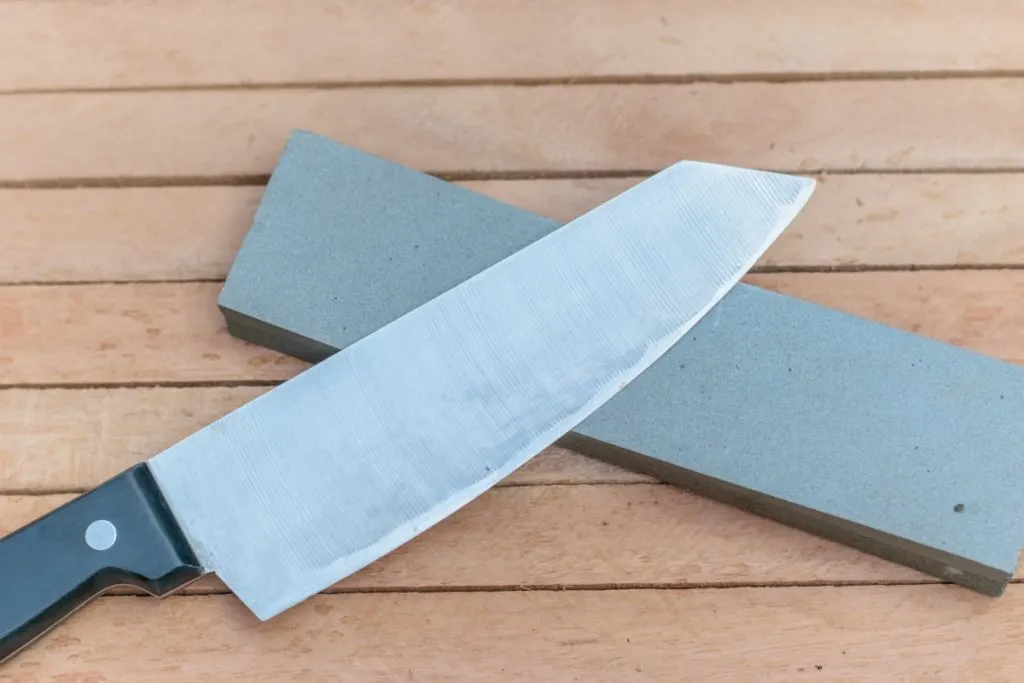
We have explained the difference between honing and sharpening, but this still leaves the question of how often your knives of different types should be sharpened.
We will examine various knife types that are typically found in most people’s possession. You may have some of these knife types, but if you are a bit of a knife nut, you may have all of these types of knives!
We will take a look at the recommended frequency of honing and sharpening for each type of knife to give you a starting point to establish your own sharpening routine.
In many of the knife types, not only does the sharpening frequency differ, but the method of sharpening and honing can also vary. Using the correct method for each knife will improve the success of your sharpening and reduce how often sharpening is required.
TIP: Are you looking to buy a new whetstone? Check out our recommendations (we personally use the first three ones):
Our PRO choice whetstones combo (Amazon links):
- Fixing stone: Whetstone SHAPTON Ceramic KUROMAKU #320
- Sharpening stone: Suehiro CERAX soaking whetstone: Medium #1000
- Finishing stone: Whetstone SHAPTON Ceramic KUROMAKU #5000
Our budget choice (Amazon link): Sharp Pebble Extra Large Sharpening Stone Set
How Often To Sharpen A Pocket Knife
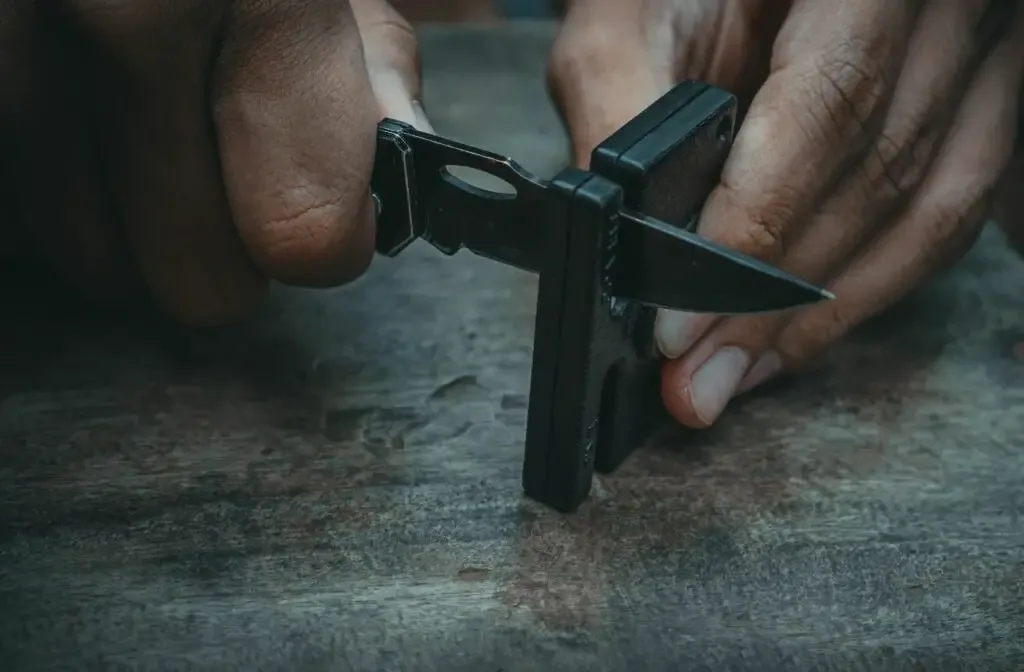
Pocket knives are some of the most frequently used knives and often suffer the most wear and tear compared to other knives you own.
Once again, the frequency of pocket knife sharpening will differ from person to person, depending on how often you put your knife to use, what you use it for, and the steel used in the blade.
Another factor affecting the frequency of pocket knife sharpening is that many pocket knives are used for tasks outside the scope of what other knives are used for. This results in the sharp edge on pocket knives experiencing more wear and tear than knives used for other purposes.
As a result of this additional wear, pocket knives will require more frequent sharpening and honing than many of your other knives.
The steel type the blade is made from on your pocket knife will also have a bearing on the frequency of honing and sharpening. Stainless steel may require more frequent sharpening than a high-carbon steel blade.
Stainless steel is typically softer than carbon steel and does not hold an edge as well as carbon steel. However, the softer stainless steel responds better to honing, and the edge can easily be restored with more frequent honing, limiting the sharpening required.
You should hone your pocket knife after every 2 to 4 uses of the knife to keep the edge in optimal condition. If you use your pocket knife every day or for rough work, you may need to increase this frequency. Honing can be done with a pocket diamond plate, a leather strop, a ceramic rod, or sharpening steel.
Sharpening should be undertaken when honing can no longer restore the sharp edge or if the edge has been damaged in some way. As a rule of thumb, you should sharpen your pocket knife at least once a month if you are a heavy user or once every two months if you are an occasional pocket knife user.
TIP: Because pocket knives are always at hand, they often take quite a lot of abuse and get used for many tasks that could dull the blade. Check out the best sharpeners for pocket knives in the article below:
The 4 Best Knife Sharpeners For Pocket Knives
How Often To Sharpen A Japanese Knife
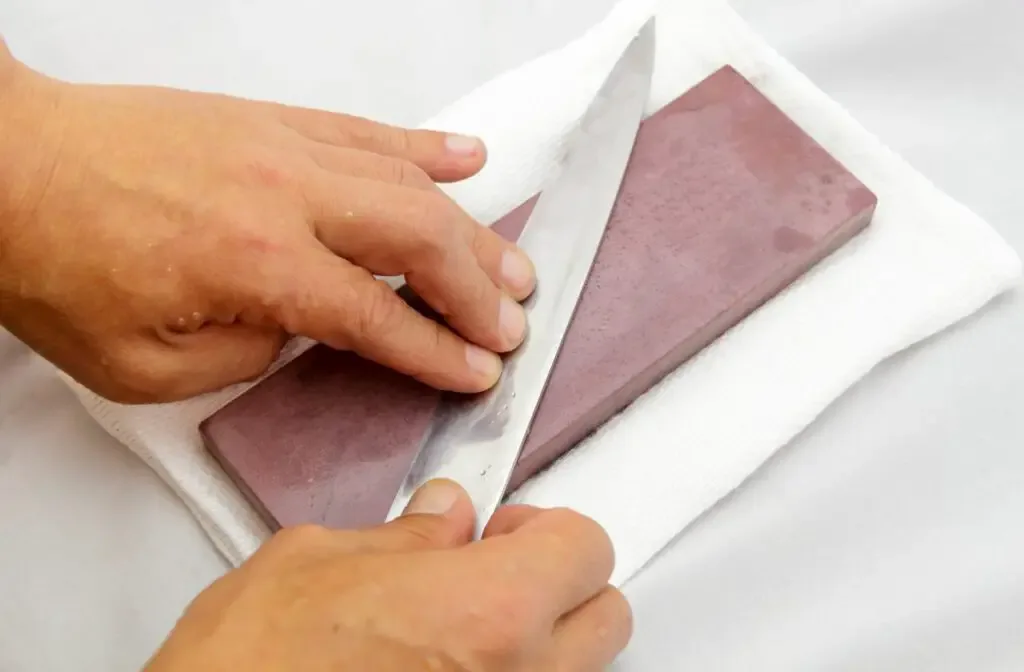
Japanese kitchen knives are the ultimate kitchen knives to own but can require special attention to their cutting edges to keep these knives functioning well.
Japanese knives are generally hardened to a higher HRC level than knives made from Western steel. This means Japanese knives hold their edge much longer than Western knives.
However, the knives should only be used for their intended purpose since the hard steel is brittle, and the edge can chip or crack if the knife is used inappropriately.
Since there are many types of Japanese knives, each with a different function, you would need to sharpen the knives based on how frequently you use the knives. A professional kitchen would need to sharpen its knives more frequently than a home cook.
A home cook would only need to sharpen their Japanese kitchen knives once every 4 – 6 months, while a professional kitchen worker may need to sharpen once a month.
Honing Japanese kitchen knives should be done either before or after every use of the knife to condition the edge. Traditional honing rods or sharpening steels should not be used to hone the edge of Japanese knives.
These honing steels push the edge back into alignment and can crack the hard steel on the fine cutting edge of Japanese knives. A high grit whetstone of 3000 or higher should be used to hone these knives.
TIP: Buying genuine Japanese kitchen knives represents a significant investment when it comes to these kitchen tools. Check out the ultimate guide on how to care for Japanese knives:
How To Care For Japanese Knives: The Complete Guide
How Often To Sharpen A Chef Knife
A chef’s knife is the hardest working knife in most kitchens due to its versatility and multipurpose function.
If you own a Gyuto, which is the Japanese equivalent of a Western chef’s knife, you should follow the sharpening frequency we have recommended for Japanese knives.
Most other chef’s knives are made from stainless steel, and the quality of the steel used in the knife and its use will determine the sharpening frequency. Lower-quality steel blades will require more frequent sharpening than higher-quality steel.
For home use, a chef’s knife should be sharpened every three months, but the knife should be honed at least twice a week. If you use the knife every day or work in a professional kitchen, you may need to increase the sharpening to every two months and the honing to daily before every use of the knife.
Chef’s knives can be honed with traditional honing or sharpening steels or on a leather strop. High grit whetstones can also be used to hone the edge.
How Often To Sharpen Kitchen Knives
The sharpening frequency for your kitchen knives will depend on the quality of the knives and how often the knives are used.
Some knives will be used more frequently than others and will require correspondingly more frequent sharpening.
Good quality knives should only require sharpening every 2 to 3 months, depending on use and honing before every use of the knife or at minimum 2 or 3 times a week.
Lesser quality kitchen knives may require sharpening every 3 to 4 weeks and should be honed every time you use the knife.
TIP: Kitchen knives can be expensive, but even if your knives are not top of the range, they still need care and maintenance. Check out the best oils for kitchen knives in the article below:
These Are The 2 Best Oils For Kitchen Knives (+ How to Use)
How Often To Sharpen Wusthof Knives
Wusthof knives are high-quality kitchen knives made from top-quality steel. The frequency of sharpening for these knives will be less than you would expect for lesser-quality knives.
The recommended frequency for sharpening for Wusthof knives is every three months. The knives should be honed daily on a honing steel before you use the knife.
It is recommended that Wusthof knives are sharpened professionally by a sharpening service at least once a year or every second year to ensure optimal performance.
The recommendation would be for frequently used knives. If you do not use your Wusthof knives daily, you can increase the time between sharpening, but the knife should still be honed before each use.
How Often To Sharpen Whittling Knives
Whittling knives are specialty knives designed to be used for whittling wood only. While they can be used for other purposes, they need to be kept extremely sharp for whittling.
The cutting edge on carving or whittling knives must be sharp to perform precise and clean cuts through wood. The frequency of sharpening for whittling knives will depend on the hardness of the wood you are carving. Hardwood will dull the blade relatively fast, while softwood will be easier on the edge.
Due to the nature of whittling, you will need to hone and sharpen your edge frequently. The recommendation is to hone your whittling knife’s edge every 30 minutes while whittling and re-sharpen the knife after every 2 hours of use.
How Often To Sharpen EDC Knife
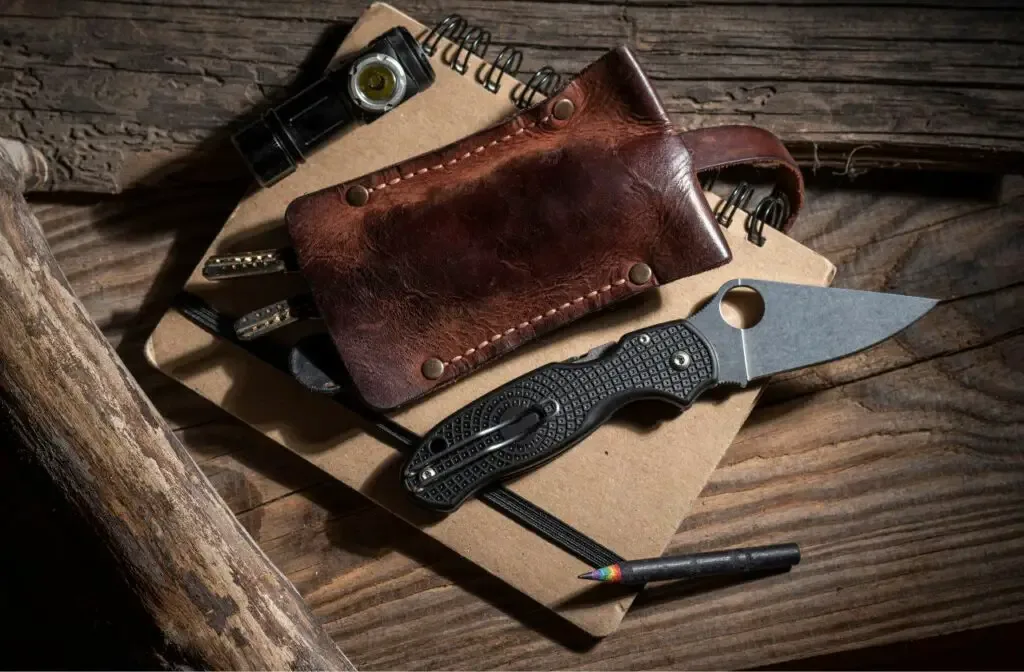
An EDC knife is similar to a pocket knife in use and function. You would typically use this knife for a variety of tasks that are uncommon for other knives.
Consequently, these knives will require additional attention for a honing and sharpening perspective.
Similar to a pocket knife, honing should be done on your EDC knife every 2 to 4 uses of the knife, and the knife should be sharpened every 1 to 2 months. If you use the knife for a particularly heavy-duty task or you use the knife daily, you may need more frequent honing and sharpening.
TIP: Keeping your knives sharper for longer is not only convenient but can also help to extend the life of your knives. Check out the simple tips for keeping your knives sharp long:
5 Simple & Proven Tips: Keeping Your Knives Sharp Longer
How Often Do Chefs Sharpen Their Knives?
Professional chefs consider their knives to be part of the tools of their trade, and as such, they keep the blades in top condition.
How often chefs sharpen their knives depends on how frequently the knives are used and how heavily they are used. The quality of the knives will also be a determining factor in the sharpening frequency.
Chefs are schooled on knife care and know the importance of honing a knife. Most chefs will hone their knives before each use of the knife. Sometimes, chefs will hone the same knife 2 or 3 times during food preparation and service, depending on how they need to use the knife.
Most chefs will sharpen their knives at least once a month, and many will send their knives in to be professionally sharpened once a year.
Recognizing the Signs of Knife Dullness
Knowing when to sharpen your knives is crucial for maintaining their performance and ensuring safety in the kitchen or field.
Regardless of whether you’re a professional chef, an outdoor enthusiast, or a home cook, understanding the signs of knife dullness will help you keep your blades in top condition.
Here’s what to look out for across different knife types and materials.
Visual Inspection and Performance Tests
Visual Clues: Start with a visual inspection of the blade under a good light source. Look for any reflections on the edge. A sharp knife will have a consistent, matte finish along the edge, while a dull blade will reflect light due to micro-abrasions and flat spots.
The Paper Test: Hold a single piece of paper upright and slice down through it with the knife. A sharp knife should cut through smoothly with little resistance. If the knife tears the paper or can’t make a clean cut, it’s time to sharpen.
The Tomato Test: Try slicing a ripe tomato. A dull knife will squish the tomato before the skin breaks, while a sharp knife will slice through effortlessly.
Specific Signs for Different Knife Types
Chef’s Knives and Kitchen Cutlery: These knives should glide through food with minimal effort. If you find yourself applying more force than usual, especially when chopping vegetables or slicing meat, it’s a clear sign of dullness.
Pocket and EDC Knives: For everyday carry knives, dullness is often noticed during routine tasks like cutting rope or opening packages. If the knife struggles or slips, it’s time for a touch-up.
Japanese Knives: Due to their harder steel, Japanese knives stay sharp longer but may develop micro-chips when dull. These require careful attention and a fine whetstone for sharpening.
Whittling and Carving Knives: A dull carving knife will cause the wood to tear or require excessive pressure, which can lead to accidents or imprecise work.
Impact of Blade Materials on Sharpening Frequency
Stainless Steel: Knife blades made from stainless steel are resistant to corrosion and are less demanding in terms of maintenance. However, they may require more frequent sharpening as the steel is generally softer than carbon steel.
Carbon Steel: Carbon steel knives can hold an edge longer but are prone to rust and require more care. They don’t need sharpening as often, but when they do, the process can be more labor-intensive.
Ceramic Blades: Ceramic knives stay sharp for an extended period but can be brittle. They seldom need sharpening, but when they do, they require specialized equipment and expertise.
High-Carbon Stainless Steel: This hybrid material offers a balance between maintaining an edge and resisting corrosion. Sharpening frequency is less than that of regular stainless steel but more than that of pure carbon steel.
Conclusion
Sharpening and honing knives is a very subjective topic, and guidelines can only be recommended for the frequency of these tasks.
As you get to know your knives, you will know when the ideal time is for your knives to be sharpened. Regular honing will help to keep the edge in good condition and reduce the need to sharpen your knives more frequently than necessary!
TIP: The best way to keep your knives sharpened is using whetstones. Check out the complete guide on how to properly sharpen knives on whetstone in the article below:
Step-By-Step GUIDE: How To Sharpen A Knife With A Whetstone
